Factors to Consider for Income Recognition and Tax Deductions for Ruby Pty Ltd
VerifiedAdded on 2023/06/09
|8
|2651
|103
AI Summary
This article discusses the factors to consider for income recognition and tax deductions for Ruby Pty Ltd, including the nature of underlying business activity, business circumstances, and size of the business. It also opines on the tax deduction for various transactions enacted by the company, such as rental property expenses, legal expenses, and market research costs.
Contribute Materials
Your contribution can guide someone’s learning journey. Share your
documents today.
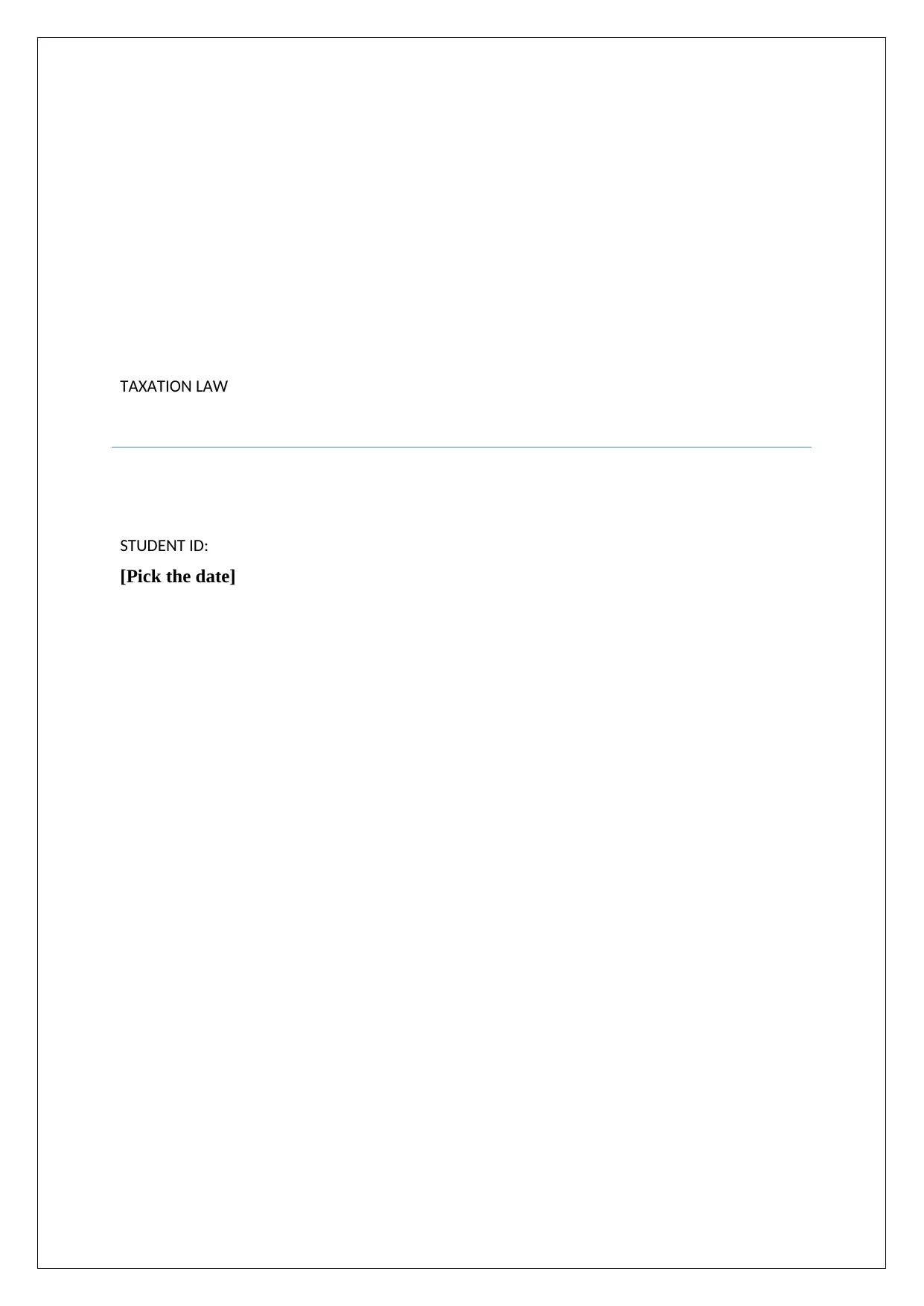
TAXATION LAW
STUDENT ID:
[Pick the date]
STUDENT ID:
[Pick the date]
Secure Best Marks with AI Grader
Need help grading? Try our AI Grader for instant feedback on your assignments.
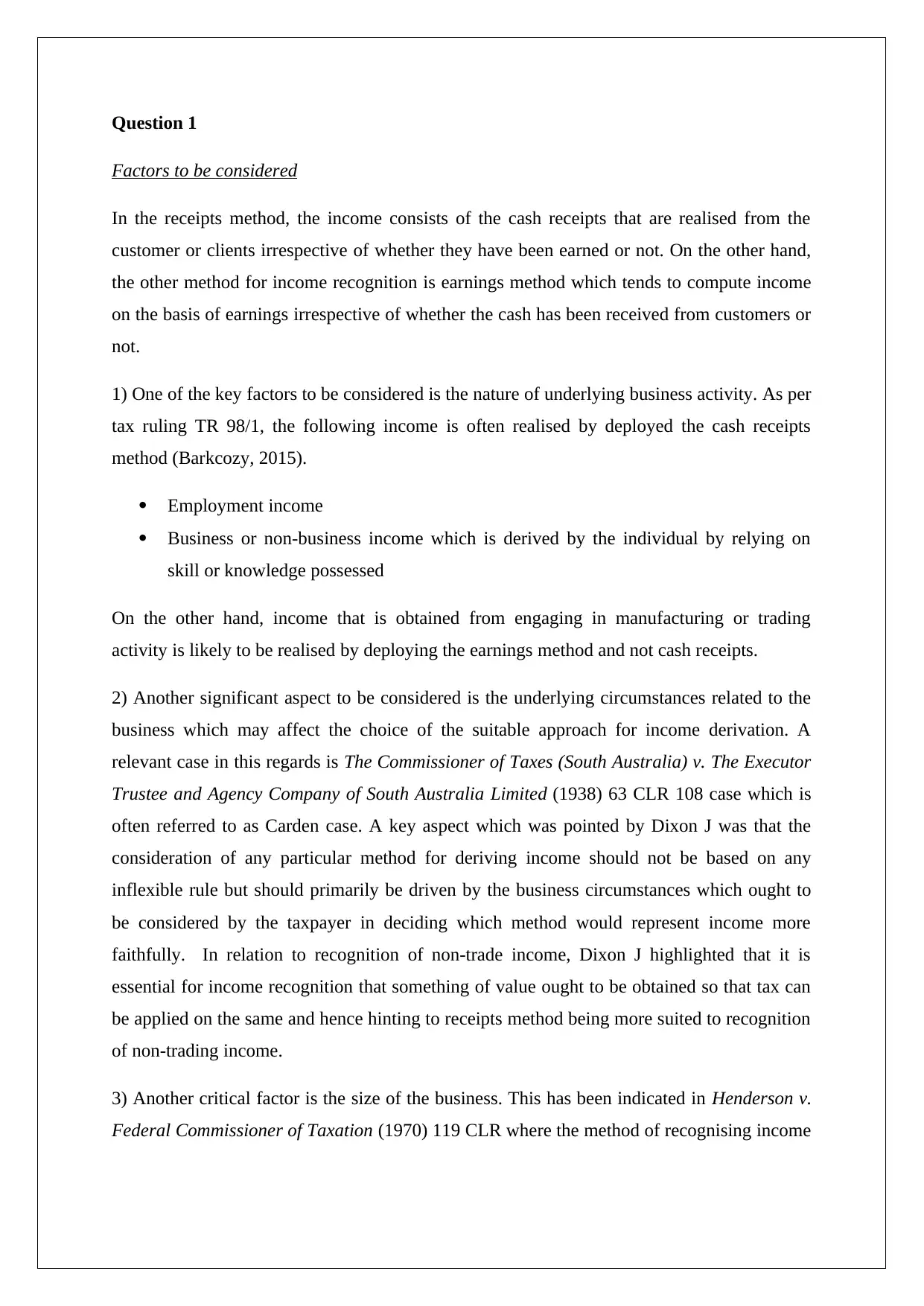
Question 1
Factors to be considered
In the receipts method, the income consists of the cash receipts that are realised from the
customer or clients irrespective of whether they have been earned or not. On the other hand,
the other method for income recognition is earnings method which tends to compute income
on the basis of earnings irrespective of whether the cash has been received from customers or
not.
1) One of the key factors to be considered is the nature of underlying business activity. As per
tax ruling TR 98/1, the following income is often realised by deployed the cash receipts
method (Barkcozy, 2015).
Employment income
Business or non-business income which is derived by the individual by relying on
skill or knowledge possessed
On the other hand, income that is obtained from engaging in manufacturing or trading
activity is likely to be realised by deploying the earnings method and not cash receipts.
2) Another significant aspect to be considered is the underlying circumstances related to the
business which may affect the choice of the suitable approach for income derivation. A
relevant case in this regards is The Commissioner of Taxes (South Australia) v. The Executor
Trustee and Agency Company of South Australia Limited (1938) 63 CLR 108 case which is
often referred to as Carden case. A key aspect which was pointed by Dixon J was that the
consideration of any particular method for deriving income should not be based on any
inflexible rule but should primarily be driven by the business circumstances which ought to
be considered by the taxpayer in deciding which method would represent income more
faithfully. In relation to recognition of non-trade income, Dixon J highlighted that it is
essential for income recognition that something of value ought to be obtained so that tax can
be applied on the same and hence hinting to receipts method being more suited to recognition
of non-trading income.
3) Another critical factor is the size of the business. This has been indicated in Henderson v.
Federal Commissioner of Taxation (1970) 119 CLR where the method of recognising income
Factors to be considered
In the receipts method, the income consists of the cash receipts that are realised from the
customer or clients irrespective of whether they have been earned or not. On the other hand,
the other method for income recognition is earnings method which tends to compute income
on the basis of earnings irrespective of whether the cash has been received from customers or
not.
1) One of the key factors to be considered is the nature of underlying business activity. As per
tax ruling TR 98/1, the following income is often realised by deployed the cash receipts
method (Barkcozy, 2015).
Employment income
Business or non-business income which is derived by the individual by relying on
skill or knowledge possessed
On the other hand, income that is obtained from engaging in manufacturing or trading
activity is likely to be realised by deploying the earnings method and not cash receipts.
2) Another significant aspect to be considered is the underlying circumstances related to the
business which may affect the choice of the suitable approach for income derivation. A
relevant case in this regards is The Commissioner of Taxes (South Australia) v. The Executor
Trustee and Agency Company of South Australia Limited (1938) 63 CLR 108 case which is
often referred to as Carden case. A key aspect which was pointed by Dixon J was that the
consideration of any particular method for deriving income should not be based on any
inflexible rule but should primarily be driven by the business circumstances which ought to
be considered by the taxpayer in deciding which method would represent income more
faithfully. In relation to recognition of non-trade income, Dixon J highlighted that it is
essential for income recognition that something of value ought to be obtained so that tax can
be applied on the same and hence hinting to receipts method being more suited to recognition
of non-trading income.
3) Another critical factor is the size of the business. This has been indicated in Henderson v.
Federal Commissioner of Taxation (1970) 119 CLR where the method of recognising income
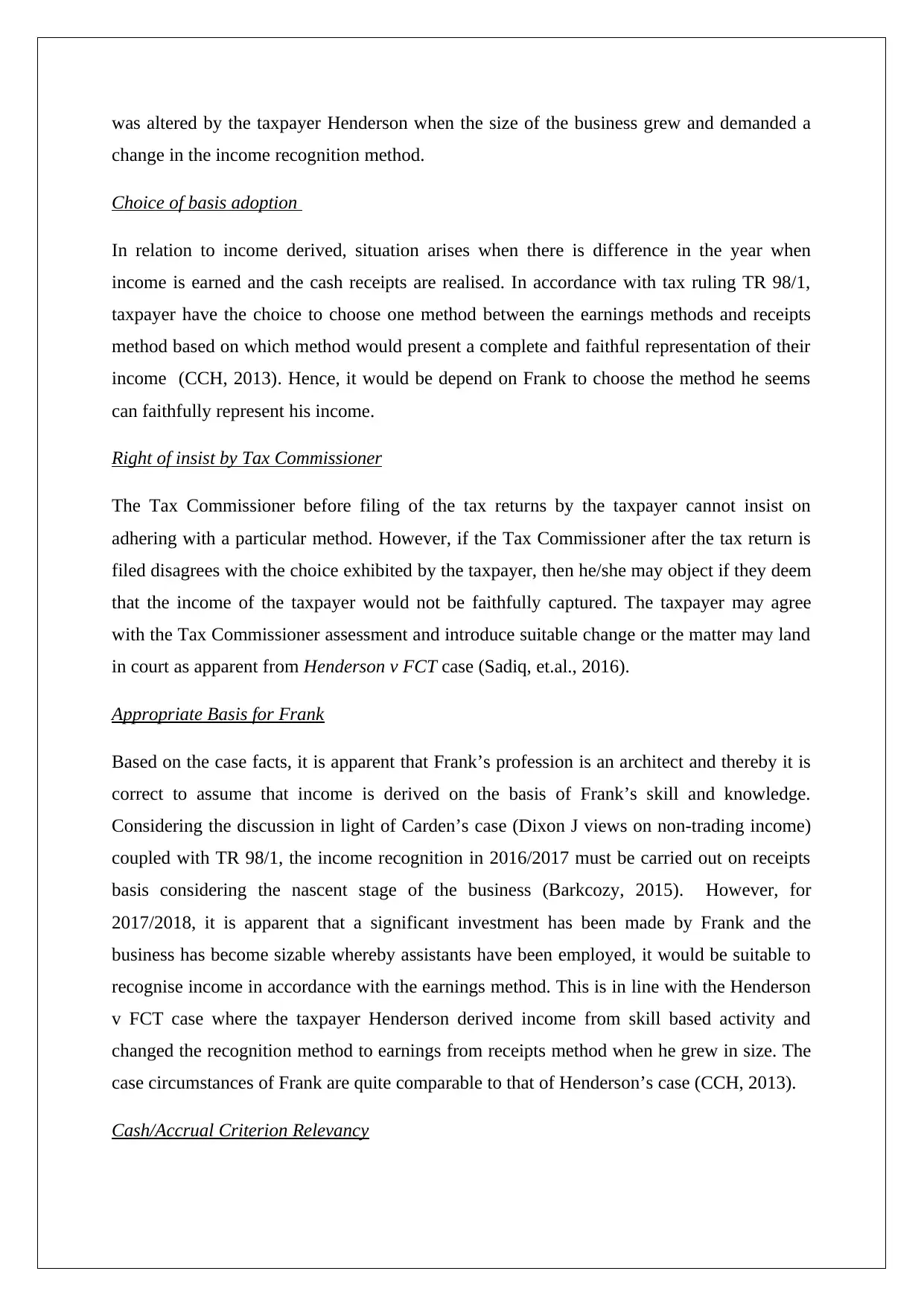
was altered by the taxpayer Henderson when the size of the business grew and demanded a
change in the income recognition method.
Choice of basis adoption
In relation to income derived, situation arises when there is difference in the year when
income is earned and the cash receipts are realised. In accordance with tax ruling TR 98/1,
taxpayer have the choice to choose one method between the earnings methods and receipts
method based on which method would present a complete and faithful representation of their
income (CCH, 2013). Hence, it would be depend on Frank to choose the method he seems
can faithfully represent his income.
Right of insist by Tax Commissioner
The Tax Commissioner before filing of the tax returns by the taxpayer cannot insist on
adhering with a particular method. However, if the Tax Commissioner after the tax return is
filed disagrees with the choice exhibited by the taxpayer, then he/she may object if they deem
that the income of the taxpayer would not be faithfully captured. The taxpayer may agree
with the Tax Commissioner assessment and introduce suitable change or the matter may land
in court as apparent from Henderson v FCT case (Sadiq, et.al., 2016).
Appropriate Basis for Frank
Based on the case facts, it is apparent that Frank’s profession is an architect and thereby it is
correct to assume that income is derived on the basis of Frank’s skill and knowledge.
Considering the discussion in light of Carden’s case (Dixon J views on non-trading income)
coupled with TR 98/1, the income recognition in 2016/2017 must be carried out on receipts
basis considering the nascent stage of the business (Barkcozy, 2015). However, for
2017/2018, it is apparent that a significant investment has been made by Frank and the
business has become sizable whereby assistants have been employed, it would be suitable to
recognise income in accordance with the earnings method. This is in line with the Henderson
v FCT case where the taxpayer Henderson derived income from skill based activity and
changed the recognition method to earnings from receipts method when he grew in size. The
case circumstances of Frank are quite comparable to that of Henderson’s case (CCH, 2013).
Cash/Accrual Criterion Relevancy
change in the income recognition method.
Choice of basis adoption
In relation to income derived, situation arises when there is difference in the year when
income is earned and the cash receipts are realised. In accordance with tax ruling TR 98/1,
taxpayer have the choice to choose one method between the earnings methods and receipts
method based on which method would present a complete and faithful representation of their
income (CCH, 2013). Hence, it would be depend on Frank to choose the method he seems
can faithfully represent his income.
Right of insist by Tax Commissioner
The Tax Commissioner before filing of the tax returns by the taxpayer cannot insist on
adhering with a particular method. However, if the Tax Commissioner after the tax return is
filed disagrees with the choice exhibited by the taxpayer, then he/she may object if they deem
that the income of the taxpayer would not be faithfully captured. The taxpayer may agree
with the Tax Commissioner assessment and introduce suitable change or the matter may land
in court as apparent from Henderson v FCT case (Sadiq, et.al., 2016).
Appropriate Basis for Frank
Based on the case facts, it is apparent that Frank’s profession is an architect and thereby it is
correct to assume that income is derived on the basis of Frank’s skill and knowledge.
Considering the discussion in light of Carden’s case (Dixon J views on non-trading income)
coupled with TR 98/1, the income recognition in 2016/2017 must be carried out on receipts
basis considering the nascent stage of the business (Barkcozy, 2015). However, for
2017/2018, it is apparent that a significant investment has been made by Frank and the
business has become sizable whereby assistants have been employed, it would be suitable to
recognise income in accordance with the earnings method. This is in line with the Henderson
v FCT case where the taxpayer Henderson derived income from skill based activity and
changed the recognition method to earnings from receipts method when he grew in size. The
case circumstances of Frank are quite comparable to that of Henderson’s case (CCH, 2013).
Cash/Accrual Criterion Relevancy
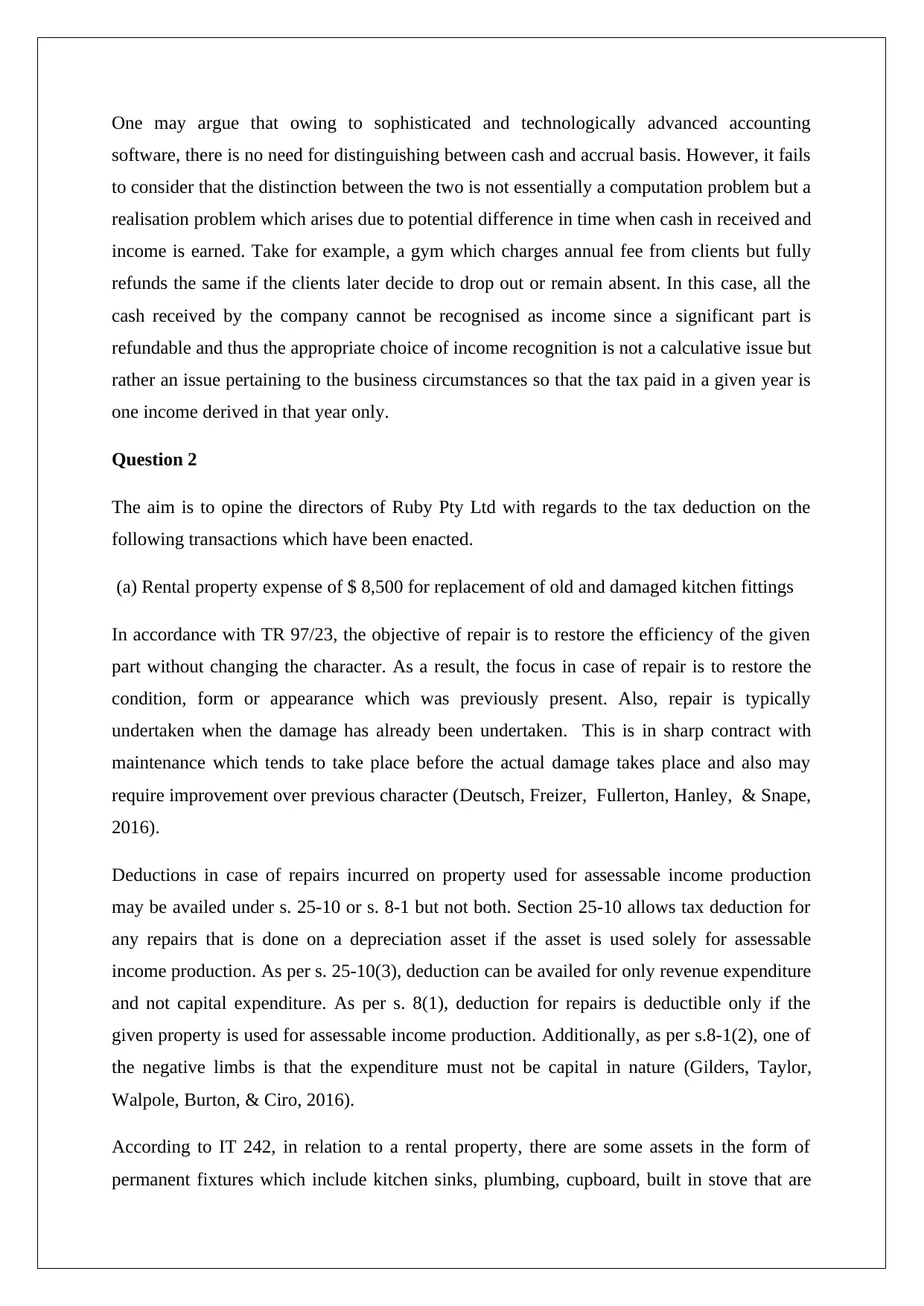
One may argue that owing to sophisticated and technologically advanced accounting
software, there is no need for distinguishing between cash and accrual basis. However, it fails
to consider that the distinction between the two is not essentially a computation problem but a
realisation problem which arises due to potential difference in time when cash in received and
income is earned. Take for example, a gym which charges annual fee from clients but fully
refunds the same if the clients later decide to drop out or remain absent. In this case, all the
cash received by the company cannot be recognised as income since a significant part is
refundable and thus the appropriate choice of income recognition is not a calculative issue but
rather an issue pertaining to the business circumstances so that the tax paid in a given year is
one income derived in that year only.
Question 2
The aim is to opine the directors of Ruby Pty Ltd with regards to the tax deduction on the
following transactions which have been enacted.
(a) Rental property expense of $ 8,500 for replacement of old and damaged kitchen fittings
In accordance with TR 97/23, the objective of repair is to restore the efficiency of the given
part without changing the character. As a result, the focus in case of repair is to restore the
condition, form or appearance which was previously present. Also, repair is typically
undertaken when the damage has already been undertaken. This is in sharp contract with
maintenance which tends to take place before the actual damage takes place and also may
require improvement over previous character (Deutsch, Freizer, Fullerton, Hanley, & Snape,
2016).
Deductions in case of repairs incurred on property used for assessable income production
may be availed under s. 25-10 or s. 8-1 but not both. Section 25-10 allows tax deduction for
any repairs that is done on a depreciation asset if the asset is used solely for assessable
income production. As per s. 25-10(3), deduction can be availed for only revenue expenditure
and not capital expenditure. As per s. 8(1), deduction for repairs is deductible only if the
given property is used for assessable income production. Additionally, as per s.8-1(2), one of
the negative limbs is that the expenditure must not be capital in nature (Gilders, Taylor,
Walpole, Burton, & Ciro, 2016).
According to IT 242, in relation to a rental property, there are some assets in the form of
permanent fixtures which include kitchen sinks, plumbing, cupboard, built in stove that are
software, there is no need for distinguishing between cash and accrual basis. However, it fails
to consider that the distinction between the two is not essentially a computation problem but a
realisation problem which arises due to potential difference in time when cash in received and
income is earned. Take for example, a gym which charges annual fee from clients but fully
refunds the same if the clients later decide to drop out or remain absent. In this case, all the
cash received by the company cannot be recognised as income since a significant part is
refundable and thus the appropriate choice of income recognition is not a calculative issue but
rather an issue pertaining to the business circumstances so that the tax paid in a given year is
one income derived in that year only.
Question 2
The aim is to opine the directors of Ruby Pty Ltd with regards to the tax deduction on the
following transactions which have been enacted.
(a) Rental property expense of $ 8,500 for replacement of old and damaged kitchen fittings
In accordance with TR 97/23, the objective of repair is to restore the efficiency of the given
part without changing the character. As a result, the focus in case of repair is to restore the
condition, form or appearance which was previously present. Also, repair is typically
undertaken when the damage has already been undertaken. This is in sharp contract with
maintenance which tends to take place before the actual damage takes place and also may
require improvement over previous character (Deutsch, Freizer, Fullerton, Hanley, & Snape,
2016).
Deductions in case of repairs incurred on property used for assessable income production
may be availed under s. 25-10 or s. 8-1 but not both. Section 25-10 allows tax deduction for
any repairs that is done on a depreciation asset if the asset is used solely for assessable
income production. As per s. 25-10(3), deduction can be availed for only revenue expenditure
and not capital expenditure. As per s. 8(1), deduction for repairs is deductible only if the
given property is used for assessable income production. Additionally, as per s.8-1(2), one of
the negative limbs is that the expenditure must not be capital in nature (Gilders, Taylor,
Walpole, Burton, & Ciro, 2016).
According to IT 242, in relation to a rental property, there are some assets in the form of
permanent fixtures which include kitchen sinks, plumbing, cupboard, built in stove that are
Secure Best Marks with AI Grader
Need help grading? Try our AI Grader for instant feedback on your assignments.
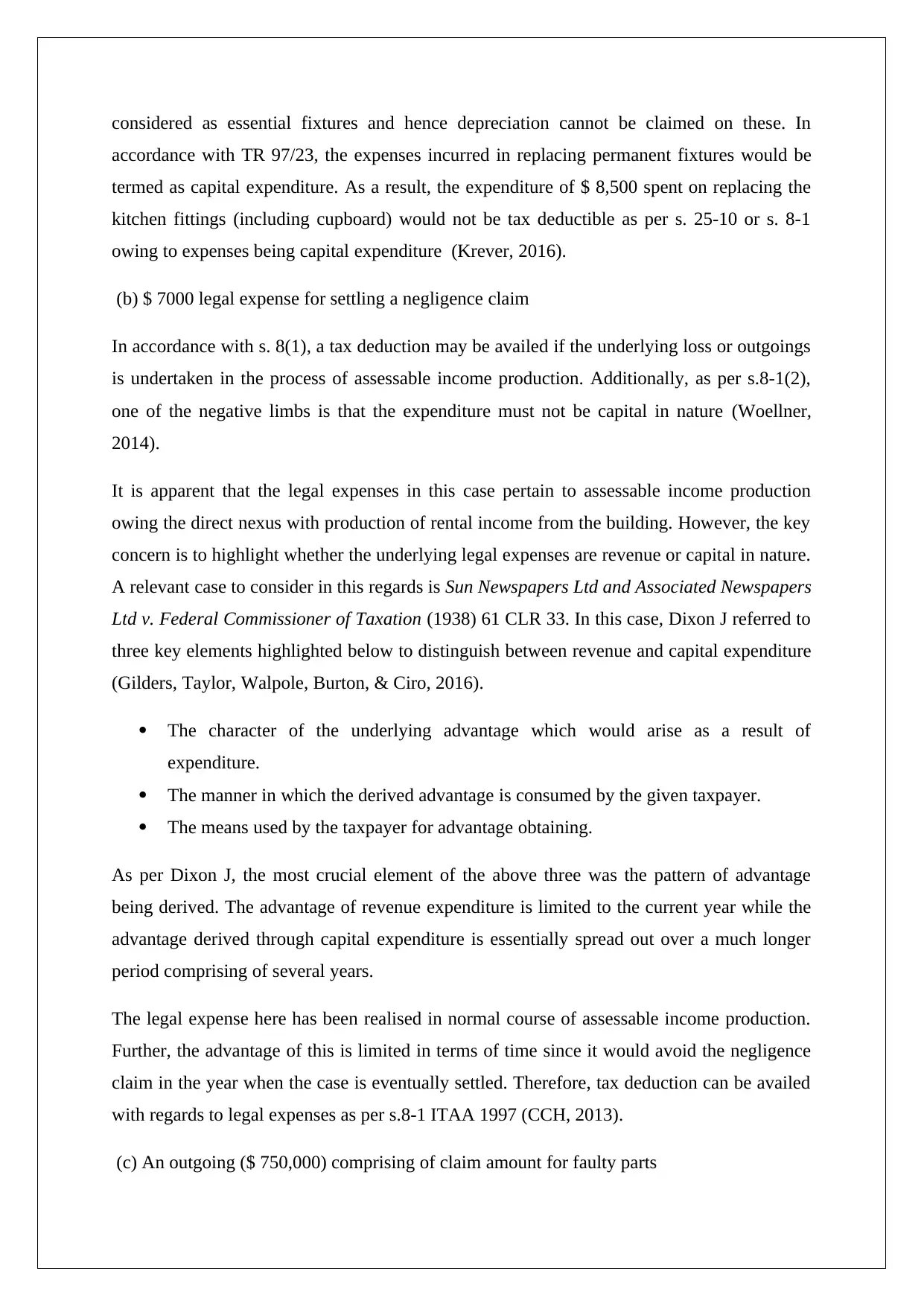
considered as essential fixtures and hence depreciation cannot be claimed on these. In
accordance with TR 97/23, the expenses incurred in replacing permanent fixtures would be
termed as capital expenditure. As a result, the expenditure of $ 8,500 spent on replacing the
kitchen fittings (including cupboard) would not be tax deductible as per s. 25-10 or s. 8-1
owing to expenses being capital expenditure (Krever, 2016).
(b) $ 7000 legal expense for settling a negligence claim
In accordance with s. 8(1), a tax deduction may be availed if the underlying loss or outgoings
is undertaken in the process of assessable income production. Additionally, as per s.8-1(2),
one of the negative limbs is that the expenditure must not be capital in nature (Woellner,
2014).
It is apparent that the legal expenses in this case pertain to assessable income production
owing the direct nexus with production of rental income from the building. However, the key
concern is to highlight whether the underlying legal expenses are revenue or capital in nature.
A relevant case to consider in this regards is Sun Newspapers Ltd and Associated Newspapers
Ltd v. Federal Commissioner of Taxation (1938) 61 CLR 33. In this case, Dixon J referred to
three key elements highlighted below to distinguish between revenue and capital expenditure
(Gilders, Taylor, Walpole, Burton, & Ciro, 2016).
The character of the underlying advantage which would arise as a result of
expenditure.
The manner in which the derived advantage is consumed by the given taxpayer.
The means used by the taxpayer for advantage obtaining.
As per Dixon J, the most crucial element of the above three was the pattern of advantage
being derived. The advantage of revenue expenditure is limited to the current year while the
advantage derived through capital expenditure is essentially spread out over a much longer
period comprising of several years.
The legal expense here has been realised in normal course of assessable income production.
Further, the advantage of this is limited in terms of time since it would avoid the negligence
claim in the year when the case is eventually settled. Therefore, tax deduction can be availed
with regards to legal expenses as per s.8-1 ITAA 1997 (CCH, 2013).
(c) An outgoing ($ 750,000) comprising of claim amount for faulty parts
accordance with TR 97/23, the expenses incurred in replacing permanent fixtures would be
termed as capital expenditure. As a result, the expenditure of $ 8,500 spent on replacing the
kitchen fittings (including cupboard) would not be tax deductible as per s. 25-10 or s. 8-1
owing to expenses being capital expenditure (Krever, 2016).
(b) $ 7000 legal expense for settling a negligence claim
In accordance with s. 8(1), a tax deduction may be availed if the underlying loss or outgoings
is undertaken in the process of assessable income production. Additionally, as per s.8-1(2),
one of the negative limbs is that the expenditure must not be capital in nature (Woellner,
2014).
It is apparent that the legal expenses in this case pertain to assessable income production
owing the direct nexus with production of rental income from the building. However, the key
concern is to highlight whether the underlying legal expenses are revenue or capital in nature.
A relevant case to consider in this regards is Sun Newspapers Ltd and Associated Newspapers
Ltd v. Federal Commissioner of Taxation (1938) 61 CLR 33. In this case, Dixon J referred to
three key elements highlighted below to distinguish between revenue and capital expenditure
(Gilders, Taylor, Walpole, Burton, & Ciro, 2016).
The character of the underlying advantage which would arise as a result of
expenditure.
The manner in which the derived advantage is consumed by the given taxpayer.
The means used by the taxpayer for advantage obtaining.
As per Dixon J, the most crucial element of the above three was the pattern of advantage
being derived. The advantage of revenue expenditure is limited to the current year while the
advantage derived through capital expenditure is essentially spread out over a much longer
period comprising of several years.
The legal expense here has been realised in normal course of assessable income production.
Further, the advantage of this is limited in terms of time since it would avoid the negligence
claim in the year when the case is eventually settled. Therefore, tax deduction can be availed
with regards to legal expenses as per s.8-1 ITAA 1997 (CCH, 2013).
(c) An outgoing ($ 750,000) comprising of claim amount for faulty parts
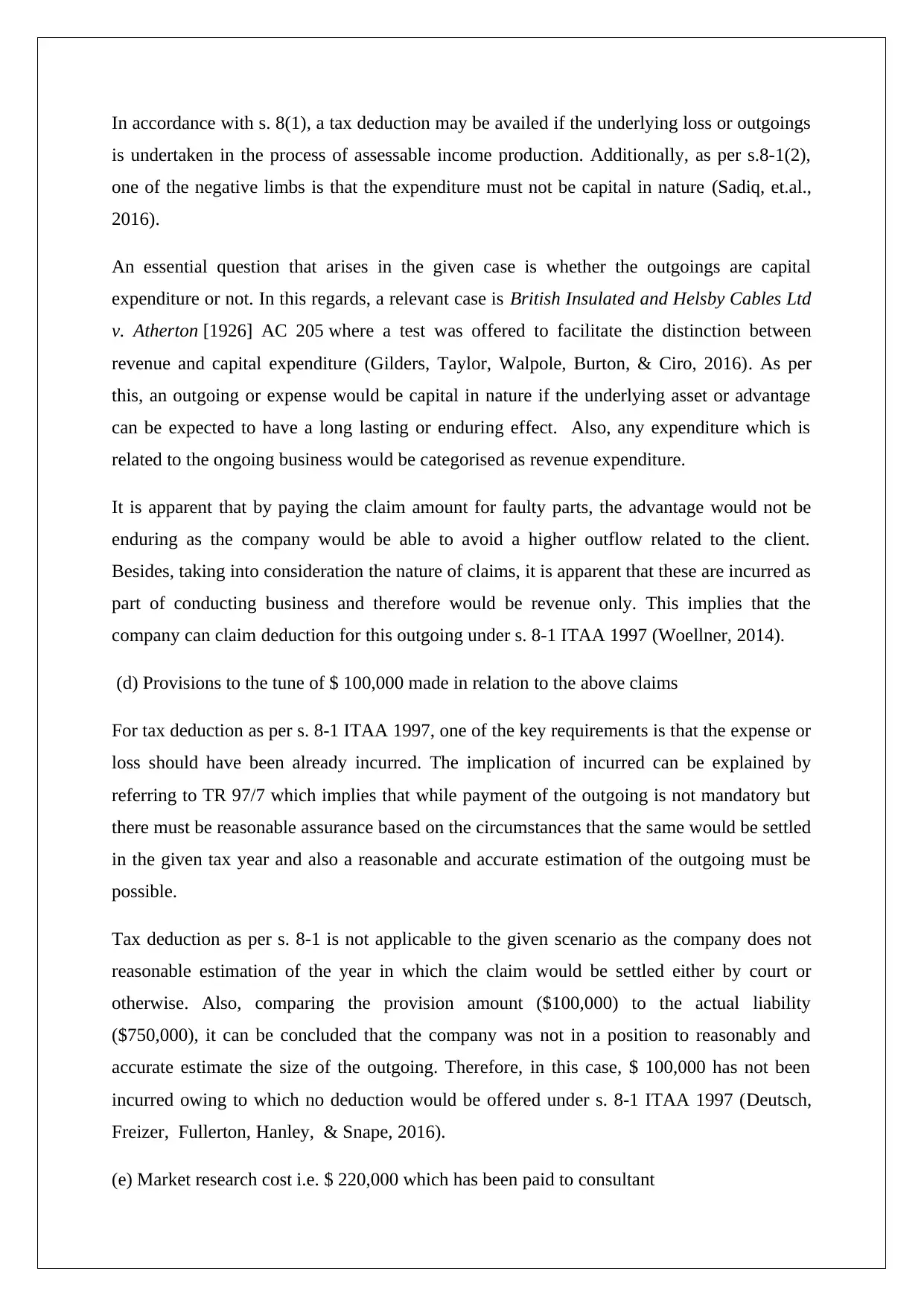
In accordance with s. 8(1), a tax deduction may be availed if the underlying loss or outgoings
is undertaken in the process of assessable income production. Additionally, as per s.8-1(2),
one of the negative limbs is that the expenditure must not be capital in nature (Sadiq, et.al.,
2016).
An essential question that arises in the given case is whether the outgoings are capital
expenditure or not. In this regards, a relevant case is British Insulated and Helsby Cables Ltd
v. Atherton [1926] AC 205 where a test was offered to facilitate the distinction between
revenue and capital expenditure (Gilders, Taylor, Walpole, Burton, & Ciro, 2016). As per
this, an outgoing or expense would be capital in nature if the underlying asset or advantage
can be expected to have a long lasting or enduring effect. Also, any expenditure which is
related to the ongoing business would be categorised as revenue expenditure.
It is apparent that by paying the claim amount for faulty parts, the advantage would not be
enduring as the company would be able to avoid a higher outflow related to the client.
Besides, taking into consideration the nature of claims, it is apparent that these are incurred as
part of conducting business and therefore would be revenue only. This implies that the
company can claim deduction for this outgoing under s. 8-1 ITAA 1997 (Woellner, 2014).
(d) Provisions to the tune of $ 100,000 made in relation to the above claims
For tax deduction as per s. 8-1 ITAA 1997, one of the key requirements is that the expense or
loss should have been already incurred. The implication of incurred can be explained by
referring to TR 97/7 which implies that while payment of the outgoing is not mandatory but
there must be reasonable assurance based on the circumstances that the same would be settled
in the given tax year and also a reasonable and accurate estimation of the outgoing must be
possible.
Tax deduction as per s. 8-1 is not applicable to the given scenario as the company does not
reasonable estimation of the year in which the claim would be settled either by court or
otherwise. Also, comparing the provision amount ($100,000) to the actual liability
($750,000), it can be concluded that the company was not in a position to reasonably and
accurate estimate the size of the outgoing. Therefore, in this case, $ 100,000 has not been
incurred owing to which no deduction would be offered under s. 8-1 ITAA 1997 (Deutsch,
Freizer, Fullerton, Hanley, & Snape, 2016).
(e) Market research cost i.e. $ 220,000 which has been paid to consultant
is undertaken in the process of assessable income production. Additionally, as per s.8-1(2),
one of the negative limbs is that the expenditure must not be capital in nature (Sadiq, et.al.,
2016).
An essential question that arises in the given case is whether the outgoings are capital
expenditure or not. In this regards, a relevant case is British Insulated and Helsby Cables Ltd
v. Atherton [1926] AC 205 where a test was offered to facilitate the distinction between
revenue and capital expenditure (Gilders, Taylor, Walpole, Burton, & Ciro, 2016). As per
this, an outgoing or expense would be capital in nature if the underlying asset or advantage
can be expected to have a long lasting or enduring effect. Also, any expenditure which is
related to the ongoing business would be categorised as revenue expenditure.
It is apparent that by paying the claim amount for faulty parts, the advantage would not be
enduring as the company would be able to avoid a higher outflow related to the client.
Besides, taking into consideration the nature of claims, it is apparent that these are incurred as
part of conducting business and therefore would be revenue only. This implies that the
company can claim deduction for this outgoing under s. 8-1 ITAA 1997 (Woellner, 2014).
(d) Provisions to the tune of $ 100,000 made in relation to the above claims
For tax deduction as per s. 8-1 ITAA 1997, one of the key requirements is that the expense or
loss should have been already incurred. The implication of incurred can be explained by
referring to TR 97/7 which implies that while payment of the outgoing is not mandatory but
there must be reasonable assurance based on the circumstances that the same would be settled
in the given tax year and also a reasonable and accurate estimation of the outgoing must be
possible.
Tax deduction as per s. 8-1 is not applicable to the given scenario as the company does not
reasonable estimation of the year in which the claim would be settled either by court or
otherwise. Also, comparing the provision amount ($100,000) to the actual liability
($750,000), it can be concluded that the company was not in a position to reasonably and
accurate estimate the size of the outgoing. Therefore, in this case, $ 100,000 has not been
incurred owing to which no deduction would be offered under s. 8-1 ITAA 1997 (Deutsch,
Freizer, Fullerton, Hanley, & Snape, 2016).
(e) Market research cost i.e. $ 220,000 which has been paid to consultant
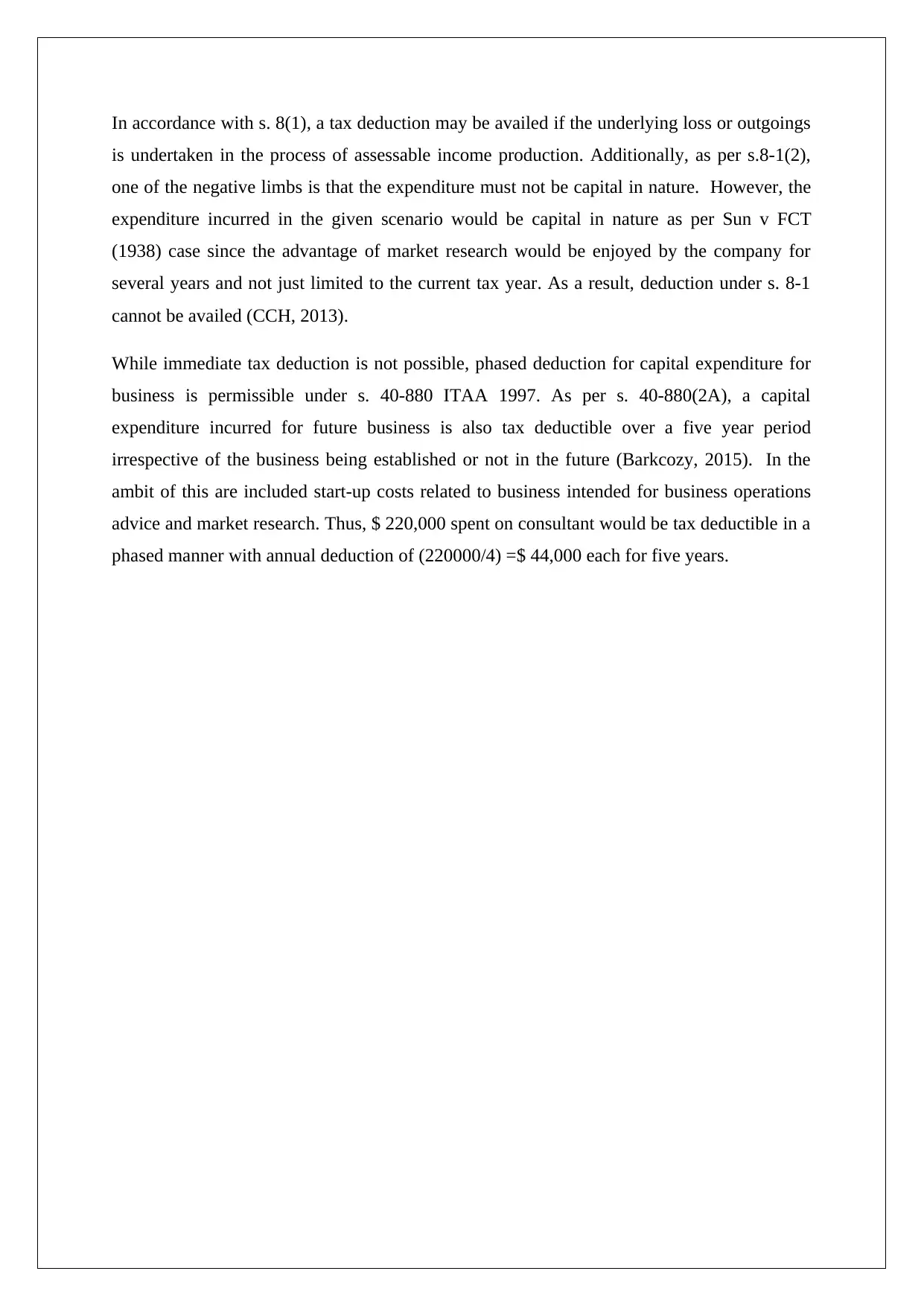
In accordance with s. 8(1), a tax deduction may be availed if the underlying loss or outgoings
is undertaken in the process of assessable income production. Additionally, as per s.8-1(2),
one of the negative limbs is that the expenditure must not be capital in nature. However, the
expenditure incurred in the given scenario would be capital in nature as per Sun v FCT
(1938) case since the advantage of market research would be enjoyed by the company for
several years and not just limited to the current tax year. As a result, deduction under s. 8-1
cannot be availed (CCH, 2013).
While immediate tax deduction is not possible, phased deduction for capital expenditure for
business is permissible under s. 40-880 ITAA 1997. As per s. 40-880(2A), a capital
expenditure incurred for future business is also tax deductible over a five year period
irrespective of the business being established or not in the future (Barkcozy, 2015). In the
ambit of this are included start-up costs related to business intended for business operations
advice and market research. Thus, $ 220,000 spent on consultant would be tax deductible in a
phased manner with annual deduction of (220000/4) =$ 44,000 each for five years.
is undertaken in the process of assessable income production. Additionally, as per s.8-1(2),
one of the negative limbs is that the expenditure must not be capital in nature. However, the
expenditure incurred in the given scenario would be capital in nature as per Sun v FCT
(1938) case since the advantage of market research would be enjoyed by the company for
several years and not just limited to the current tax year. As a result, deduction under s. 8-1
cannot be availed (CCH, 2013).
While immediate tax deduction is not possible, phased deduction for capital expenditure for
business is permissible under s. 40-880 ITAA 1997. As per s. 40-880(2A), a capital
expenditure incurred for future business is also tax deductible over a five year period
irrespective of the business being established or not in the future (Barkcozy, 2015). In the
ambit of this are included start-up costs related to business intended for business operations
advice and market research. Thus, $ 220,000 spent on consultant would be tax deductible in a
phased manner with annual deduction of (220000/4) =$ 44,000 each for five years.
Paraphrase This Document
Need a fresh take? Get an instant paraphrase of this document with our AI Paraphraser
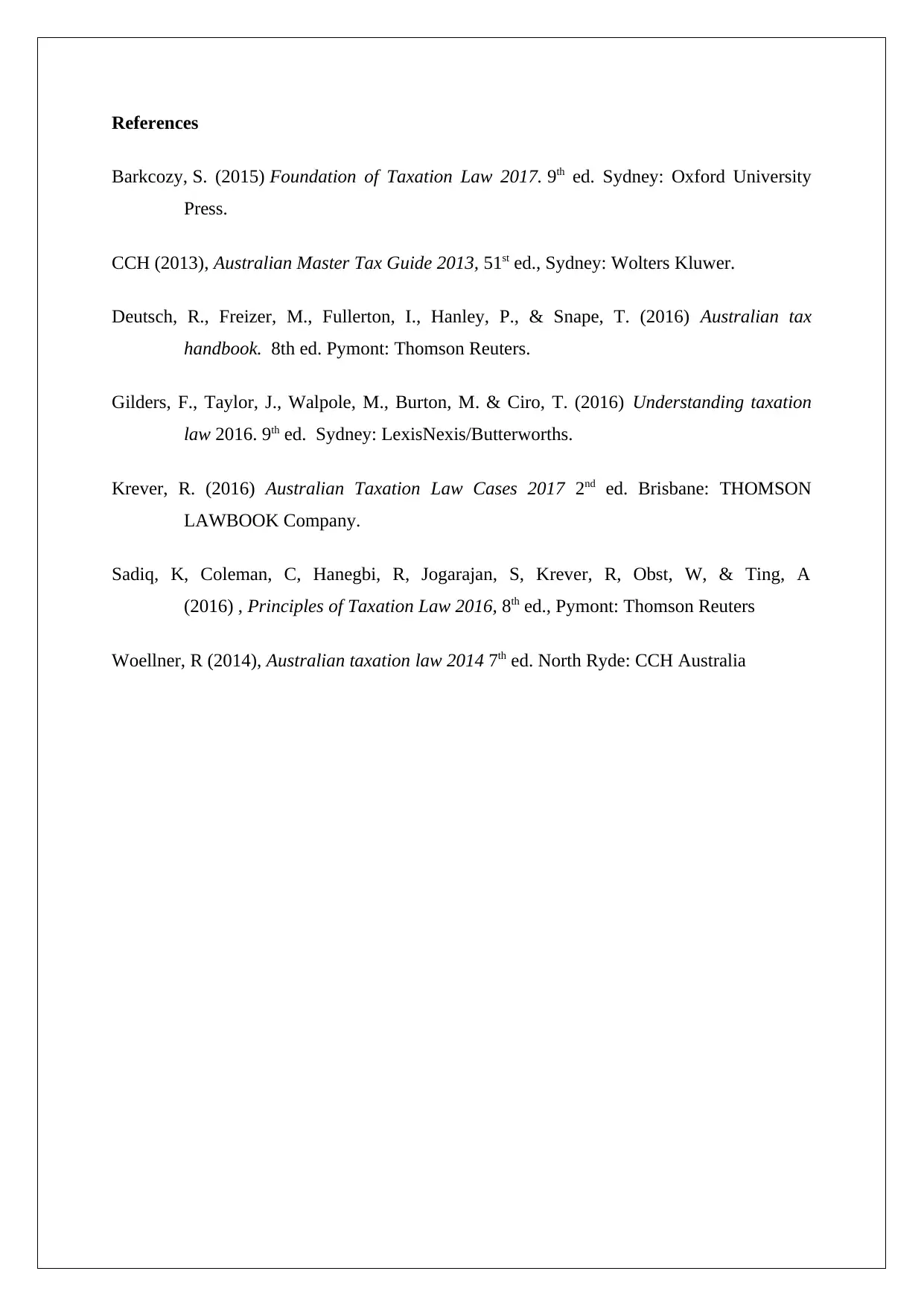
References
Barkcozy, S. (2015) Foundation of Taxation Law 2017. 9th ed. Sydney: Oxford University
Press.
CCH (2013), Australian Master Tax Guide 2013, 51st ed., Sydney: Wolters Kluwer.
Deutsch, R., Freizer, M., Fullerton, I., Hanley, P., & Snape, T. (2016) Australian tax
handbook. 8th ed. Pymont: Thomson Reuters.
Gilders, F., Taylor, J., Walpole, M., Burton, M. & Ciro, T. (2016) Understanding taxation
law 2016. 9th ed. Sydney: LexisNexis/Butterworths.
Krever, R. (2016) Australian Taxation Law Cases 2017 2nd ed. Brisbane: THOMSON
LAWBOOK Company.
Sadiq, K, Coleman, C, Hanegbi, R, Jogarajan, S, Krever, R, Obst, W, & Ting, A
(2016) , Principles of Taxation Law 2016, 8th ed., Pymont: Thomson Reuters
Woellner, R (2014), Australian taxation law 2014 7th ed. North Ryde: CCH Australia
Barkcozy, S. (2015) Foundation of Taxation Law 2017. 9th ed. Sydney: Oxford University
Press.
CCH (2013), Australian Master Tax Guide 2013, 51st ed., Sydney: Wolters Kluwer.
Deutsch, R., Freizer, M., Fullerton, I., Hanley, P., & Snape, T. (2016) Australian tax
handbook. 8th ed. Pymont: Thomson Reuters.
Gilders, F., Taylor, J., Walpole, M., Burton, M. & Ciro, T. (2016) Understanding taxation
law 2016. 9th ed. Sydney: LexisNexis/Butterworths.
Krever, R. (2016) Australian Taxation Law Cases 2017 2nd ed. Brisbane: THOMSON
LAWBOOK Company.
Sadiq, K, Coleman, C, Hanegbi, R, Jogarajan, S, Krever, R, Obst, W, & Ting, A
(2016) , Principles of Taxation Law 2016, 8th ed., Pymont: Thomson Reuters
Woellner, R (2014), Australian taxation law 2014 7th ed. North Ryde: CCH Australia
1 out of 8
Related Documents
Your All-in-One AI-Powered Toolkit for Academic Success.
+13062052269
info@desklib.com
Available 24*7 on WhatsApp / Email
![[object Object]](/_next/static/media/star-bottom.7253800d.svg)
Unlock your academic potential
© 2024 | Zucol Services PVT LTD | All rights reserved.





